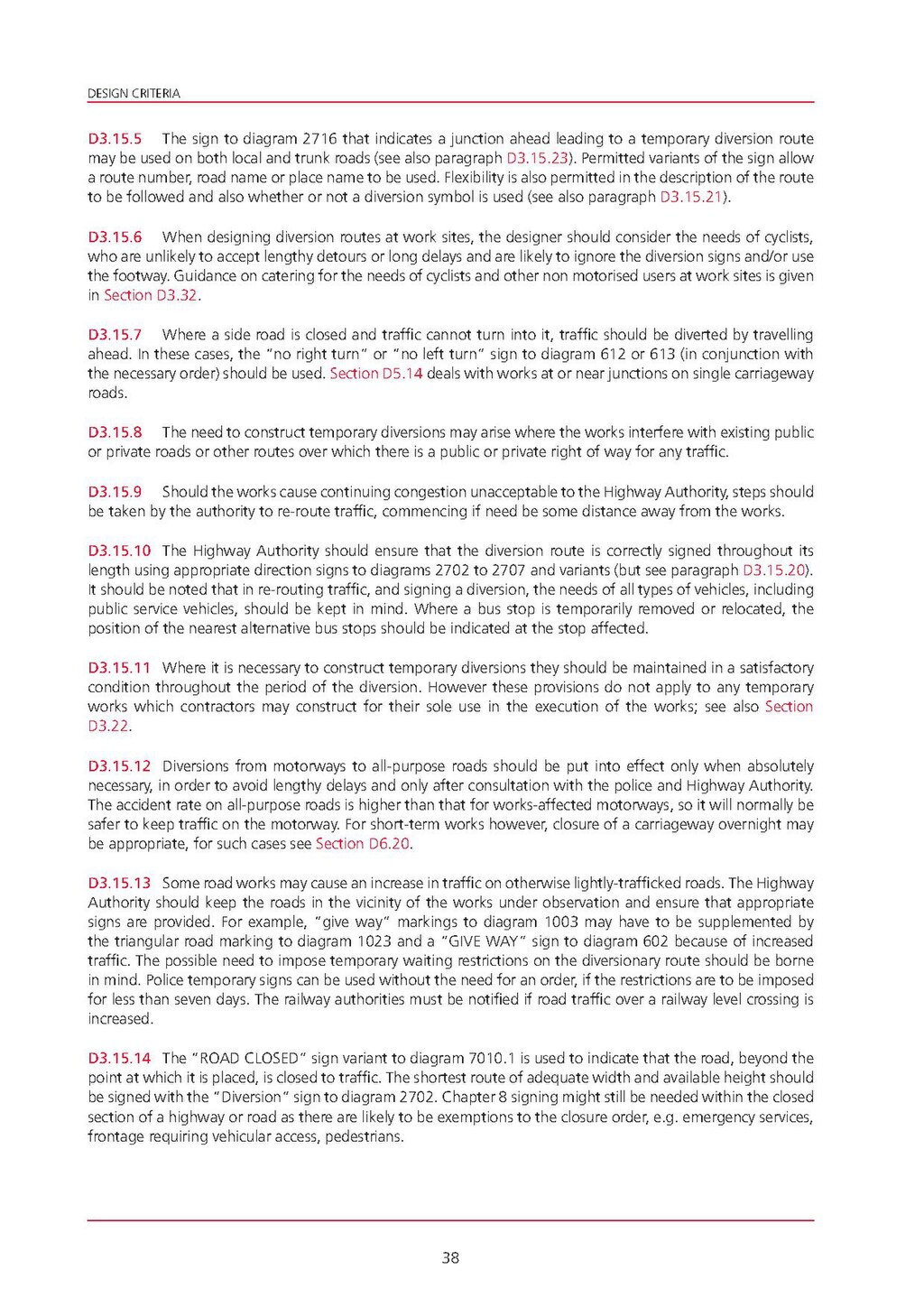D3.15.5 The sign to diagram 2716 that indicates a junction ahead leading to a temporary diversion route may be used on both local and trunk roads (see also paragraph D3.15.23). Permitted variants of the sign allow a route number, road name or place name to be used. Flexibility is also permitted in the description of the route to be followed and also whether or not a diversion symbol is used (see also paragraph D3.15.21).
D3.15.6 When designing diversion routes at work sites, the designer should consider the needs of cyclists, who are unlikely to accept lengthy detours or long delays and are likely to ignore the diversion signs and/or use the footway. Guidance on catering for the needs of cyclists and other non motorised users at work sites is given in Section D3.32.
D3.15.7 Where a side road is closed and traffic cannot turn into it, traffic should be diverted by travelling ahead. In these cases, the "no right turn" or "no left turn" sign to diagram 612 or 613 (in conjunction with the necessary order) should be used. Section D514 deals with works at or near junctions on single carriageway roads.
D3.15.8 The need to construct temporary diversions may arise where the works interfere with existing public or private roads or other routes over which there is a public or private right of way for any traffic.
D3.15.9 Should the works cause continuing congestion unacceptable to the Highway Authority, steps should be taken by the authority to re-route traffic, commencing if need be some distance away from the works.
D3.15.10 The Highway Authority should ensure that the diversion route is correctly signed throughout its length using appropriate direction signs to diagrams 2702 to 2707 and variants (but see paragraph D3.15.20). It should be noted that in re-routing traffic, and signing a diversion, the needs of all types of vehicles, including public service vehicles, should be kept in mind. Where a bus stop is temporarily removed or relocated, the position of the nearest alternative bus stops should be indicated at the stop affected.
D3.15.11 Where it is necessary to construct temporary diversions they should be maintained in a satisfactory condition throughout the period of the diversion. However these provisions do not apply to any temporary works which contractors may construct for their sole use in the execution of the works; see also Section D3.22.
D3.15.12 Diversions from motorways to all-purpose roads should be put into effect only when absolutely necessary, in order to avoid lengthy delays and only after consultation with the police and Highway Authority. The accident rate on all-purpose roads is higher than that for works-affected motorways, so it will normally be safer to keep traffic on the motorway. For short-term works however, closure of a carriageway overnight may be appropriate, for such cases see Section D6.20.
D3.15.13 Some road works may cause an increase in traffic on otherwise lightly-trafficked roads. The Highway Authority should keep the roads in the vicinity of the works under observation and ensure that appropriate signs are provided. For example, "give way" markings to diagram 1003 may have to be supplemented by the triangular road marking to diagram 1023 and a "GIVE WAY" sign to diagram 602 because of increased traffic. The possible need to impose temporary waiting restrictions on the diversionary route should be borne in mind. Police temporary signs can be used without the need for an order, if the restrictions are to be imposed for less than seven days. The railway authorities must be notified if road traffic over a railway level crossing is increased.
D3.15.14 The "ROAD CLOSED" sign variant to diagram 7010.1 is used to indicate that the road, beyond the point at which it is placed, is closed to traffic. The shortest route of adequate width and available height should be signed with the "Diversion" sign to diagram 2702. Chapter 8 signing might still be needed within the closed section of a highway or road as there are likely to be exemptions to the closure order, e.g. emergency services, frontage requiring vehicular access, pedestrians.
38
